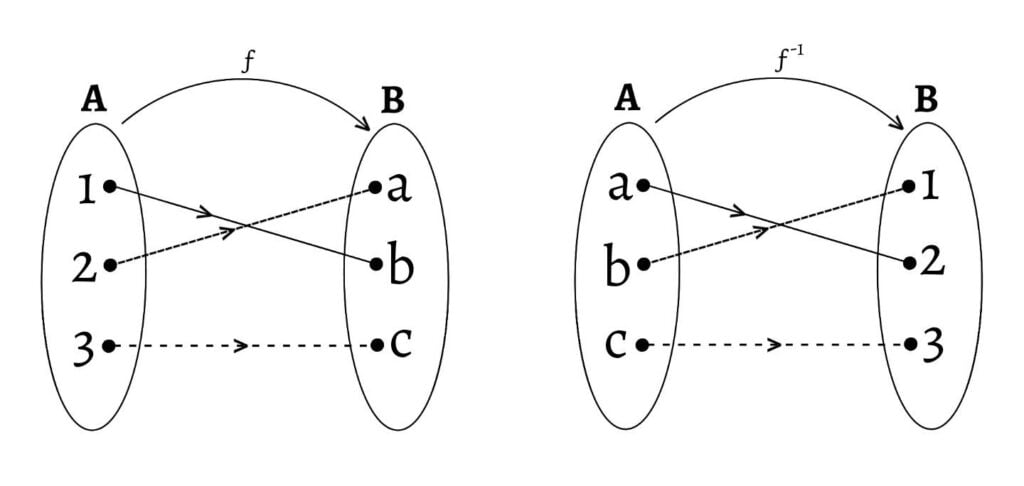Inverse Image of an Element
Consider a function $ƒ: A\to B$. The inverse image of an element $y∈B$ with respect to $ƒ$ is defined as the set of elements in $A$ which have $y$ as their image. It is denoted by $ƒ^{-1}(y)$. \[ƒ^{-1}(y)=\{x∈A: y=ƒ(x)\}\] Examples:
- Let $ƒ: A\to B$ be defined by the arrow diagram,

Then, the inverse of $a$ under $ƒ$ \[ƒ^{-1}(a)=\{1,2\}\] and, $ƒ^{-1}(b)$ is a null set. \[ƒ^{-1}(c)=3\]
2. Let a function $ƒ: R\to R$ be defined by $ƒ(x)=x^2$. Then, \[ƒ^{-1}(9)=\{-3,3\}\] ∵ $9$ is the image of both $-3$ and $3$. Also, \[ƒ^{-1}(-1)=Φ\] ∵ There is no real number whose square is $-1$.
Inverse Function
Let $ƒ: A\to B$ be a bijective function. Since $ƒ$ is onto, each element $b∈B$ is an image of at least one element $a∈A$. But, $ƒ$ is also one-one, so $a$ is the only (or unique) element of $A$ corresponding to the element $b∈B$. Inverse function, a function from $B$ to $A$, associates each element $b$ of $B$ with a unique element $a$ of $A$. In other words, a function of the type; \[ƒ^{-1}:B\rightarrow A\] This function is known as the inverse function of $ƒ$.
Thus, if $ƒ: A\to B$ is one-one and onto, then ther exists a function $ƒ^{-1}: B\to A$ called the inverse function of $ƒ$ and is defined as a function in which every element of $B$ associates with a unique element of $A$.
Examples:
- Let $ƒ: A\to B$ be one-one and onto function defined by the following diagram,

2. Let a function $ƒ: R\to R$ be defined by $ƒ(x)=x^3$. This function is bijective. Hence, $ƒ^{-1}$ exists and is defined by \[ƒ^{-1}(x)=\sqrt[3]{x}\]
Q. Let a function $ƒ: R\to R$ be defined by $y=ƒ(x)=2x-3$, $x∈R$. Find the inverse function.
Let $x_1, x_2 ∈ R$ (domain). Then, \[ƒ(x_1)=2x_1-3\] \[ƒ(x_2)=2x_2-3\] Now, \[ƒ(x_1)=ƒ(x_2)\] \[\Rightarrow 2x_1-3=2x_2-3\] \[\Rightarrow x_1=x_2\] ∴ $ƒ$ is one-one.
Again, let $k ∈ R$. Then, \[k=2x-3\] \[\Rightarrow x=\frac{k+3}{2}∈R\] ∴ $ƒ$ is onto.
Since, $ƒ$ is one-one and onto, it is a bijective function and $ƒ^{-1}$ exists. We have, \[y=2x-3\]
Interchanging the values of $x$ and $y$, we get, \[x=2y-3\] \[y=\frac{x+3}{2}\] \[\therefore ƒ^{-1}(x)=\frac{x+3}{2}\]
More on Relations And Functions
- Ordered Pair And Cartesian Product
- Relations
- Function
- Types of Functions
- Real-valued Functions And Algebra of Real-valued Functions
- Composition of Functions
